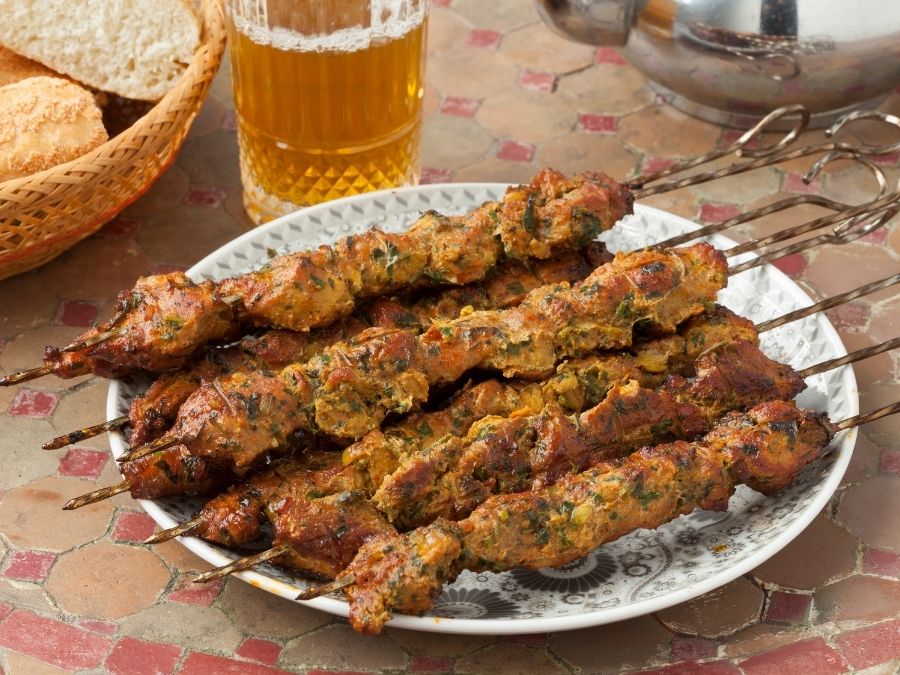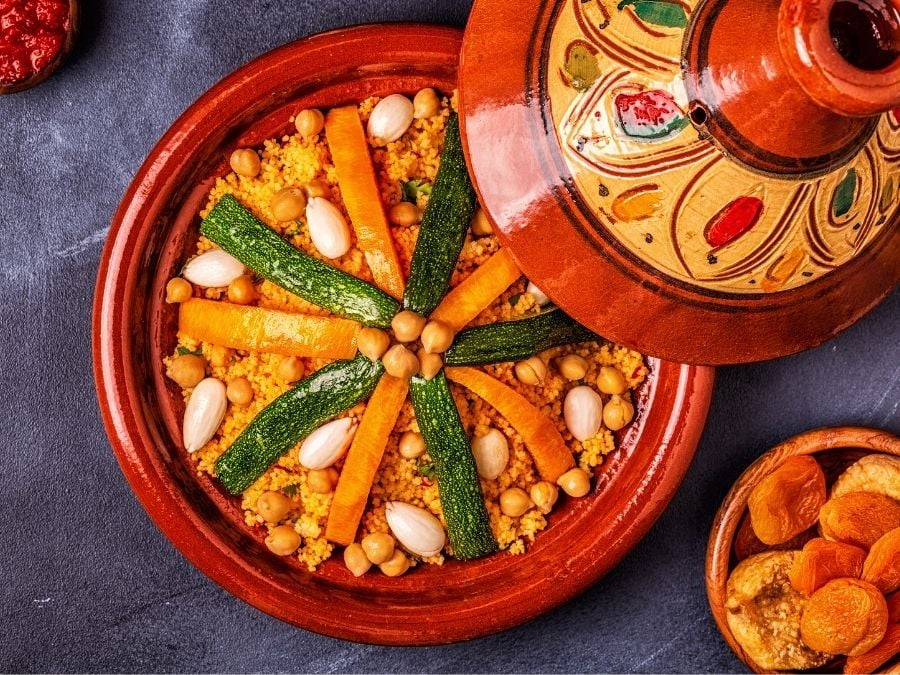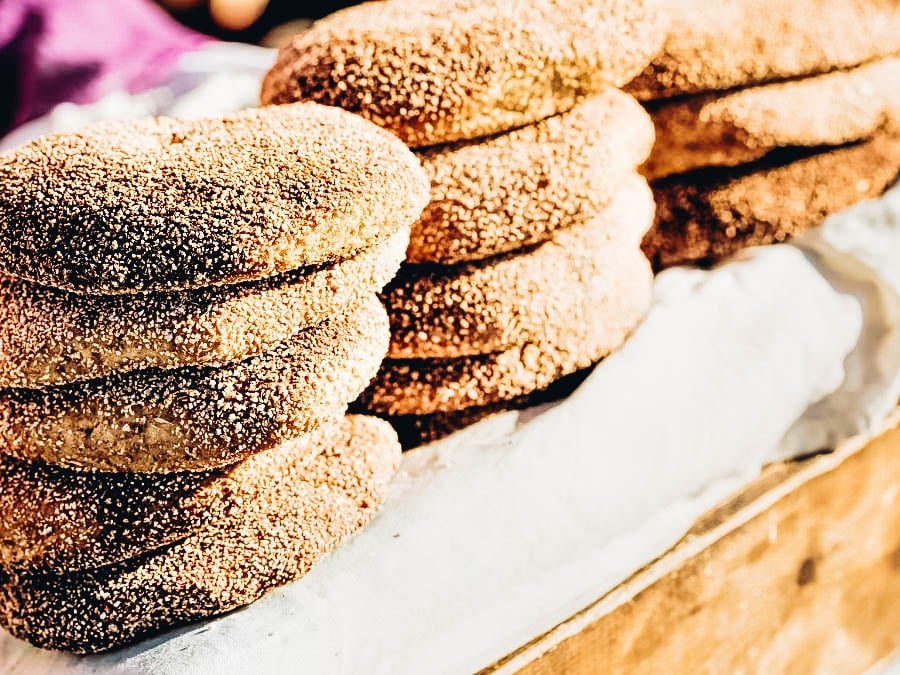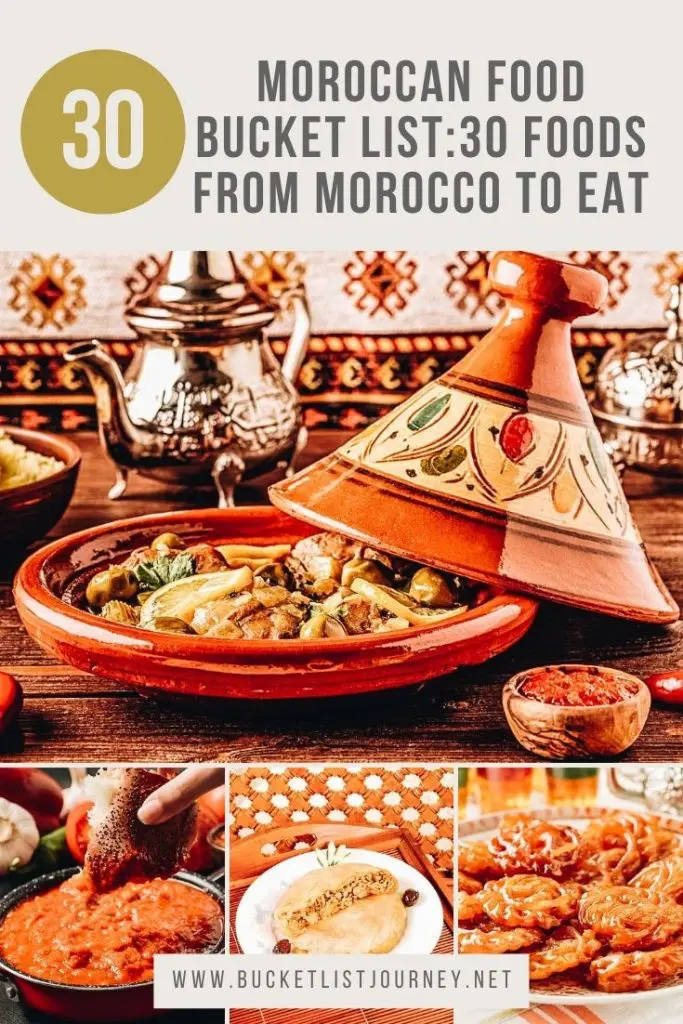Aside from couscous, we may not yet be as familiar with Morocco foods as we should be. Moroccan cuisine is filled with intriguing flavors, adventurous dishes and spices (without ever getting particularly spicy). The food from Morocco has a long history, with its dishes having drawn influences from various cultures, most notably Berber and French cuisines, but also with Jewish and Arabic influences present. Let this list tickle your tongue with its deliciousness and get onto trying these traditional and classic Moroccan dishes!
Names of the Best Moroccan Dishes and Foods from Morocco to Eat
1. Almond Snake Pastry (M’hancha)
Let’s start off with M’hanncha, a traditional Moroccan dessert. Don’t let the name freak you out, it doesn’t actually contain any part of a snake, it’s simply shaped like one! This pastry is made of warqa dough, which has been filled with almond paste, with cinnamon and orange-flower water used for additional flavoring.
Recipe: Moroccan Almond Snake Pastry Recipe – M’hancha by Christine Benlafquih
2. Amlou Dip
Amlou is another dish from Morocco in which almond is heavily used. Other ingredients include argan oil and honey. This dip is a specialty of Morocco’s southern parts and can be served together with various foods from Morocco, as well as pastries, scones, and even bread. The texture of amlou can be likened to Nutella, and similarly to Nutella in Italy, it is a staple find in most pantries in Morocco.

3. Batbout Sandwich
The traditional Batbout sandwich is a Moroccan style pita bread, which is cooked on the stove, in a skillet or possibly on a griddle. For filling, you can use various vegetables together with chicken or tuna; or you can also eat the batbout bread as it is, or with things like jam or honey spread on top of it.
Recipe: Batbout – Moroccan Pita Bread Recipe by Christine Benlafquih
4. B’ssara
Made with dried fava beans, this soup is especially popular in Northern Morocco. Although only a couple of ingredients go into the soup – garlic and olive oil in addition to the beans – it’s full of flavor. It can then be topped with olive oil, paprika, and cumin, as well as lemon juice, and it may be eaten by dipping bread into the dish.
Recipe: Moroccan Fava Bean and Vegetable Soup by Martha Rose Shulman
5. Bastilla or Pastilla (Pigeon Pie)
This is a Moroccan dish that plays with both sweet and savory flavors. It’s a kind of a layered pie, with a lot of warqa dough layers, a layer with almonds, a layer with pigeon, and so on. The Moroccan pigeon pie is commonly served during any type of celebration.
Recipe: Authentic Pastilla Recipe by tasteatlas
6. Briouats
These small pastries are made from warqa dough, filled with various filling options, and then fried before serving. It may be filled with something sweet such as almond paste, or something more savory like chicken or ground meat. They’re popular to serve during Ramadan as a dish to break the fast with, but they are also eaten as appetizers and finger foods, and sometimes even as entrees.
Recipe: Moroccan Kefta (Ground Meat) Briouat Recipe by Christine Benlafquih

7. Brochettes (Kebabs)
Brochettes are Moroccan, and North African in general, skewers, with the term being used to refer to skewers in general. It’s a popular food eaten from the street vendors, typically made from lamb or beef, but chicken variations exist as well. Especially during the Eid al-Adha holiday it becomes popular to grill kebabs for a meal in Moroccan homes.
Recipe: Moroccan Chicken Brochettes by Anisa Helou

8. Chickpea Stew
This classic from the Moroccan kitchen makes for some perfect wintertime eating, with how hearty and warming the dish is. Besides chickpeas, the integral ingredients to make chickpea stew are onions, tomatoes, lemon zest and juice, and chicken stock, as well as the spices cumin, paprika, garlic powder, and chili flakes. The stew can be eaten on its own, but it’s perhaps at its best when served together with some freshly baked flatbread.
Recipe: Moroccan Chickpea Stew by Mari
9. Couscous
Perhaps the best known of all Morocco foods is couscous, the staple food found across the North African cuisines, as well as in many kitchens worldwide today. It is made from semolina, which is a type of durum wheat. In Morocco specifically, couscous is often served with stewed vegetables, as well as meat. It can also be served as a final course of a meal.
Recipe: Moroccan Couscous with Roasted Vegetables Chick Peas and Almonds by Cooking Classy

10. Dates
Dates are an especially popular dessert to have during the Ramadan season. With Medjool dates as the most popular kind of dates in Morocco, there are actually more than 100 different varieties of dates from the almost 6 million date trees in existence in Morocco! Dates are commonly consumed just as is, but some people will also eat stuffed dates, or include dates in a meal with chicken and couscous, among other options.
11. Fish Chermoula
Chermoula itself stands for a marinade, but it’s a pretty staple one to combine with just about every fish dish in Morocco. Whether we’re talking about fried sardines or fish tagine, chermoula is often present. Chermoula is made from cilantro, garlic, paprika, cumin, lemon, and saffron threads.
Recipe: Moroccan Chermoula Marinade by Christine Benlafquih
12. Gazelle Horns (Kaab El Ghazal)
Don’t let the name get you skipping any heartbeats – there are no real gazelle horns eaten in this dish! Instead, Kaab el Ghazal is actually a dessert dish, a crescent-shaped cookie to be precise. It’s made from flour-based dough and it’s filled with almond paste that has been flavored by orange flower water; due to its high price it is typically served only during special events, coupled with a cup of tea.
Recipe: Kaab el Ghazal – Gazelle Horns (Cornes de Gazelle) by Christine Benlafquih
13. Ghoriba Cookies
A traditional cookie from Morocco, utilizing almond as one of its main ingredients, is ghoriba. These are shortbread cookies, in which the tops are a little cracked, ground almonds and sesame seeds adding to the crunchiness, the dough itself consisting of the usual shortbread cookie ingredients: sugar, flour, baking powder, butter, and vanilla sugar. These cookies are best eaten with hot tea, any time of the year.
Recipe: Moroccan Almond Cookies by Azlin Bloor

14. Harira
The Harira soup is another traditional Moroccan recipe, consisting of harissa, parsley, cilantro, tomato, chickpeas, and lentils, as well as possibly fermented butter or lamb. It’s full of flavor and spices, and makes for a great hearty meal. Harira is traditionally eaten during Ramadan, but can be eaten as a breakfast, appetizer, or main dish any time of year, usually served with slices of lemon, figs, bread, and chebakia, which is a honey and rosewater flavored pastry.
Recipe: Harira (Spiced Moroccan Vegetable Soup with Chickpeas, Cilantro, and Lemon) by King Solomon’s Table
15. Hout Quari (Sardine Meatball Sandwich)
Hout Quari is another fish dish from Moroccan cuisine, specifically a Moroccan style sandwich with a sardine fish filling. The fish goes through a food processor first, and the mixture paste is then shaped into fish balls, which are grilled or fried in a pan before being put in the sandwich and topped with toppings such as onions, tomato sauce, harissa, green olives, and smen. These are a common dish sold at the street vendors.
Recipe: Moroccan Fish Recipe: Hout Quari by MarocMama
16. Kefta Meatball Tagine ( Kefta Mkaouara (Mkawra))
Served in a North African style earthenware pot tagine, this is a flavorful and spicy comfort food kind of a dish that’s a classic to the Moroccan kitchen. The meatballs, called kefta mkaouara among locals, are cooked in tomato sauce, and traditionally poached eggs are included in the dish as well, making the dish somewhat similar to shakshuka, with the latter not involving meatballs in the recipe. Typically the meatballs are spiced with cilantro, cumin, onion, paprika, parsley, pepper, and salt, and you can also include cayenne pepper or chili peppers in the sauce itself.
Recipe: Moroccan Kefta Tagine with Tomato Sauce – Kefta Mkaouara (Mkawra) by Christine Benlafquih
17. Khobz
Served during nearly every meal, khobz is a Moroccan style flatbread, that is thicker than typical types of flatbreads, and most of the time made in a round shape. It’s made out of a variety of flours, such as white flour or semolina, cooked in the oven, and it can be used to fork or scoop up dishes like tagines, salads, and various other Moroccan dishes, instead of using utensils. It’s easy to make at home, but also available at any bakery in Morocco.
Recipe: Basic Moroccan White Bread (Khobz) by Christine Benlafquih

18. Maakouda
Maakouda is a Moroccan potato cake, or perhaps a potato fritter more specifically. You’ll find it sold at numerous street vendors in Morocco, either served plainly or as a sandwich filling, the sandwich bread in use typically being khobz. It may also be served as a side dish or an appetizer.
Recipe: Maakouda – Moroccan Potato Cakes by Kate Hackworthy
19. Matbucha
Also incredibly popular to eat in Israel, Matbucha is a type of a salad made of tomatoes and bell peppers. As the name itself suggests, it’s more of a cooked salad, with an appearance more closely resembling a tomato sauce than a traditional salad. It’s commonly eaten as a side dish for a bigger meal, but it also works great when eaten over fish.
Recipe: Matbucha by Tori Avey

20. Mechoui
Mechoui is a lamb leg or shoulder that has been slow roasted, although the really traditional method calls for roasting a whole lamb. Once the roasting is done, with it possibly taking even up to nine hours to reach the amazingly tender consistency, the meat is then eaten by hand, with salt or cumin, or alternatively by dipping it into something. Typically, mechoui is served at the beginning of a meal, especially offered during feasts.
Recipe: Moroccan Mechoui (Slow Roasted Leg of Lamb or Shoulder) by Christine Benlafquih
21. Mint Tea
Morocco’s mint tea, which is green tea in which a whole bunch of spearmint has been steeped into, is famous worldwide and quite a large symbol of Moroccan cuisine and culture. It is served several times throughout the day, whether over a meal or simply when the mood strikes, and it’s not common for invited and drop-in guests to enjoy the tea together with the host. One aspect for which the Moroccan mint tea is particularly famous is its relatively high consistency of sugar, so don’t forget to add some if making the tea at home (or be shocked by the sweetness of the tea when trying it in Morocco)!
Recipe: Morrocan Mint Tea by Sackville
22. Msemen
Msemen is another kind of flatbread that is a common part of Moroccan cuisine, as well as Algeria and Tunisia. It is traditionally made from flour, durum wheat semolina, melted butter, dry yeast, salt, and sugar, as well as a bit of water, with a somewhat more complicated cooking technique than khobz, resulting in thin squares of bread. It can be enjoyed with some mint tea or coffee, or simply with honey, or alternatively it can be stuffed with fillings like meat or vegetables.
Recipe: Msemen, square shaped Crispy Moroccan Pancake (Rghaif) by Azlin Bloor
23. Rfissa
Served during various different kinds of celebrations, especially to celebrate childbirth, rfissa is a chicken and lentils dish, served over shredded msemen. Its broth is seasoned with Ras el Hanout (a Moroccan spice blend), seeds of fenugreek, saffron, and various other spices. This is also considered to be a comfort food in Morocco.
Recipe: Moroccan Chicken Rfissa – Trid Pastry with Chicken, Lentils, and Fenugreek by Christine Benlafquih
24. Chebakia
These are cookies made out of dough with sesame seeds as an integral ingredient, shaped like a flower, fried, and coated with honey prior to serving. Because of how time consuming these cookies are to make, it is usually prepared with some help, and served during Ramadan or other more special occasions and celebrations.
Recipe: Chebakia (Moroccan Sesame Cookies) by Hilda’s Kitchen Blog
25. Sheep Head
Sheep’s head is a dish that’s commonly served in Morocco during special occasions, specifically during one of its biggest holidays of the year, Eid Al Adha. You can get sheep heads from markets any time of the year, but during this particular holiday it’s common for the family to butcher their own sheep to make meals out of. The usual way to prepare the head for a meal is to steam it, although you can also find roasted sheep heads at street vendors.
Recipe: Moroccan Steamed Sheep’s Head by Christine Benlafquih
26. Snail Soup (Babbouche)
Babbouche is a common find at Moroccan street vendors. The Moroccan white snails require slow cooking over low heat, and at least for this particular dish, more than a dozen different spices are used to flavor up the snails. The broth itself is nicely peppered up.
Recipe: Morocco Snail Soup by Nomadic Chef
27. Stuffed Camel Spleen
This is another dish that is particularly a Moroccan specialty, with camel spleen as the main ingredient. For filling, camel meat, lamb, ground beef, olives, hump fat, and various spices are used. All of this is then baked in an oven, before it gets sliced and fried, after which it is finally served as a sandwich filling, for example as a filling to a batbout sandwich.
Recipe: Moroccan Stuffed Spleen Recipe – Tihane or Rate Farcie by Christine Benlafquih
28. Tajine or Tagine
Tajine dishes are foods from Morocco named so after the earthenware pot in which they are cooked and served. There are various tajines, all of which are slow cooked, served in Morocco; in addition to the kefta meatballs mentioned above, tajine dishes are often also made with lamb and various combinations, or chicken, or simply with vegetables, commonly sweet and sour being combined into one tagine meal. Tajines are often eaten by dipping bread into the dish for scooping.
Recipe: Moroccan Chicken Tagine by Jenn Segal
29. Taktouka
Taktouka is another Moroccan style salad, made from green bell peppers, tomatoes, olive oil, and garlic. It can also be eaten as a dip, namely by dipping some flatbread into the dish. Taktouka can also be used as a filling for a sandwich, or as a side dish to some fish or meat.
Recipe: Moroccan Taktouka by Abi Olayiwola
30. Zaalouk
Lastly, Zaalouk is also a Moroccan style salad. It is made out of tomatoes and eggplants, with cumin, garlic, herbs, and paprika used to season the dish. The eggplants don’t have to be roasted, but it is recommended to reach maximum deliciousness levels, before serving the salad as dip to flatbread.
Recipe: Moroccan Zaalouk (Cooked Eggplant and Tomato Salad) by Christine Benlafquih
Besides being diverse and full of flavor, Morocco foods are also known for how popular they are to be served in large quantities to share among family or friends. I highly recommend you try Moroccan cuisine, apart from just couscous, as it is delicious and it is always loads of fun to get to try different dishes from new cultures. Especially the fact that many different cultures and cuisines have blended into Moroccan cuisine over a long period of time makes the cooking of Moroccan cuisine truly intriguing to try out!
Traveling Soon? Use my Favorite Resources for Booking Your Trip!
Book Your Flight
Expedia is my favorite flight search engine, because it checks dozens of airlines so you can easily find the best fare deals. You can also select ‘Watch Prices’ to get an email alert when the prices change.
Book Your Accommodations
I use both Booking.com and Expedia for hotels, because each offers a couple different hotel choices and I like to compare the reviews on each one. If you have a group or are looking for more of a home atmosphere, head over to VRBO or AirBNB that has houses, apartments and even just a room for rent in every price range.
Book Your Rental Car
If love the freedom to explore like I do, driving from place to place is the best option! I always book with RentalCars.com (it’s part of booking.com) for the best prices and top brand options.
Book Some Fun Tours!
Viator and Get Your Guide are my go-to search engines for cool bucket list experiences! Each one can have different tours, so check both—why limit yourself, right?
Don’t Forget Travel Insurance
Travel can be unpredictable. Whether it’s a last-minute cancellation, an injury, or (ugh) theft, things happen. That’s why I recommend never leaving the country without travel insurance. Here are my faves: Safety Wing and World Nomads.
Get Packing & Travel Essentials Ready
Check out the Bucket List Journey Amazon Store to find all my favorite travel essentials. Everything from Packing cubes, to travel adapters and toiletry containers to walking shoes.
*Lastly, check travel.state.gov for visa requirements and safety information.
Save this Post to Pinterest

More Food Related Bucket Lists
German Food Bucket List: 45 Names of the Best Traditional Dishes to Try
American Food Bucket List: 60 Foods in the USA to Eat
Mexican Food Bucket List: 60+ Traditional Dishes to Eat from Mexico
Italian Food Bucket List: 50+ Best Traditional Foods From Italy to Eat
Greek Food Bucket List: 30 Traditional Dishes to Eat From Greece
Jamaican Food Bucket List: 50+ Foods to Eat from Jamaica
























Whitney, the sheep’s head is definitely a no for me. It still has the teeth. Jennifer El Mekkaoui, I have seen sheep’s head served a few times in the last 34 years. I am sad to not see sardines on the list. They are stuffed with a little paste of spices and fried. We eat them with zalouk and olives. They’re my favorite. Sifha is another one missing. It’s angel hair pasta, steamed in the couscousierre, with sugar, cinnamon, and almonds. A roasted chicken is usually served with it.